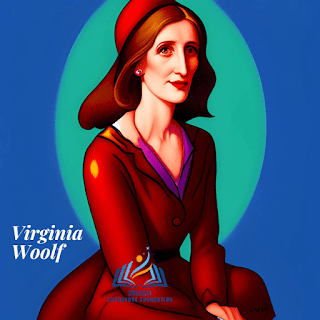"Unveiling the Depths: Exploring 'Mrs Dalloway' by
Virginia Woolf - A Journey through Time, Identity, and Society"
I. Introduction
Virginia Woolf, a prominent figure in modernist literature,
penned the renowned novel "Mrs Dalloway." This masterpiece holds
significant literary importance for its innovative narrative techniques and
profound exploration of human consciousness. As a modernist novel, "Mrs
Dalloway" pushes the boundaries of traditional storytelling, immersing
readers in a complex web of thoughts, emotions, and societal reflections.
II. Background and Context
Set in post-World War I London, "Mrs Dalloway"
reflects the historical and social context of the time. The aftermath of the
war had left a lasting impact on society, influencing people's perceptions and
experiences. Woolf's writing style and narrative techniques, characterized by
stream of consciousness and interior monologues, allow readers to delve deep
into the characters' minds and gain a nuanced understanding of their thoughts
and motivations.
III. Characters: A Tapestry of Lives
Woolf's skill in character development shines through in
"Mrs Dalloway," as she brings to life a diverse cast of individuals,
each grappling with their own hopes, fears, and desires. Let's explore some of
the key characters that drive the narrative forward:
- Clarissa Dalloway: The eponymous protagonist, Clarissa Dalloway, is a complex and introspective woman. Her internal thoughts and reflections reveal a longing for the fulfillment of her youthful dreams and deep contemplation of the passage of time.
- Septimus
Warren Smith: Septimus, a shell-shocked war veteran, serves as a
contrasting figure to Clarissa. His struggle with post-traumatic stress
disorder and his detachment from society highlights the profound impact of
war on the human psyche.
- Peter
Walsh: A former suitor of Clarissa's, Peter Walsh, represents a pivotal
connection to her past. As he reenters her life, old memories and emotions
resurface, leading to introspection and self-discovery.
IV. Plot Summary
At the center of the novel is Clarissa Dalloway, the main
protagonist, whose role unfolds throughout the narrative. The story encompasses
a single day in London as Clarissa prepares for a grand party she is hosting in
the evening. As the day progresses, Woolf provides glimpses into Clarissa's past
and present, exploring her relationships, desires, and societal expectations.
Alongside Clarissa's story, Woolf weaves in the parallel narrative of Septimus
Smith, a war veteran grappling with the psychological aftermath of the war. The
intersection of these two narratives allows for a deeper exploration of the
complexities of the human experience.
Detailed Summary part Wise
Part I: "The Window"
The novel opens with Clarissa Dalloway, a middle-aged woman,
preparing for her party. As she walks through the streets of London, her
thoughts and observations provide insights into her character and the society
in which she lives. Woolf's masterful use of stream-of-consciousness technique
allows us to delve deep into Clarissa's mind, revealing her innermost desires
and anxieties.
Part II: "Mrs Dalloway in Bond Street"
In this section, we are introduced to Septimus Warren Smith,
a shell-shocked veteran haunted by his experiences in the war. Septimus and his
wife, Lucrezia, struggle to cope with his deteriorating mental state. Through
Septimus, Woolf explores the devastating effects of war on the human psyche and
raises questions about societal expectations and the marginalization of those
who do not conform.
Part III: "The Unnamed Clarissa"
Returning to Clarissa Dalloway's perspective, we witness her
interactions with various characters at her party. As the evening progresses,
Clarissa reflects on her past, particularly her relationship with Peter Walsh,
a former suitor. The contrast between the vibrant atmosphere of the party and
Clarissa's inner melancholy underscores the theme of the disparity between
appearance and reality.
Part IV: "The Music Room"
In the final section, the narrative culminates with a
dramatic turn of events. Septimus, overwhelmed by his inner turmoil, takes his
own life. This tragic event serves as a stark reminder of the profound impact
of mental health issues and the often overlooked struggles of individuals in
society. Woolf's exploration of themes such as sanity, isolation, and the
nature of existence leaves a lasting impression on the reader.
V. Themes and Motifs
"Mrs Dalloway" delves into several compelling
themes and motifs. The theme of time pervades the novel, as characters confront
the fleeting nature of existence and grapple with the passage of time. Woolf
also examines the role of social class and gender in shaping individuals'
lives, highlighting the constraints and expectations imposed by society. The
motif of appearances versus reality is recurrent, prompting readers to question
the masks people wear and the truth beneath the surface. Furthermore, the theme
of isolation and the search for connection underpin the characters' journeys,
illuminating the human longing for meaningful relationships.
Themes: Exploring the Human Experience
"Mrs Dalloway" explores a myriad of themes that
resonate deeply with readers. Through Woolf's exquisite prose and introspective
narrative, the following themes emerge:
- Time
and Memory: The passage of time and the power of memory are central themes
in the novel. Woolf skillfully interweaves past and present, showcasing
how memories shape our perception of the world and influence our choices.
"What a lark! What a plunge! For so it had always
seemed to her, when, with a little squeak of the hinges, which she could hear
now, she had burst open the French windows and plunged at Bourton into the open
air." - Virginia Woolf, Mrs Dalloway
- Identity
and Self-Reflection: Woolf invites readers to contemplate the complexities
of personal identity and the masks individuals wear to conform to societal
expectations. The characters in "Mrs Dalloway" navigate their
inner struggles, seeking authenticity and self-fulfillment.
"But she could not love him, she thought, throwing
her head back in despair, for he was not Clarissa. And, lying back, she felt
herself tossed up, thrown up, on to the beach." - Virginia Woolf, Mrs
Dalloway
- Society
and Repression: Woolf presents a critical examination of societal norms
and the repression individuals often face in conforming to societal
expectations. The characters in the novel grapple with their desires, the
fear of judgment, and the stifling effect of social conventions.
VI. Symbolism and Imagery
Throughout "Mrs Dalloway," Woolf employs rich
symbolism and vivid imagery. Symbols such as flowers and the clock hold deeper
significance within the narrative. Flowers represent the transient beauty of
life, while the clock serves as a reminder of time's relentless march. Woolf's
use of stream of consciousness, a narrative technique that immerses readers in
the characters' uninterrupted flow of thoughts, adds a layer of significance to
the imagery, capturing the intricacies of their inner lives. London itself
becomes a symbolic space, reflecting the social and psychological landscape of
the characters.
VII. Style and Language
Woolf's writing style in "Mrs Dalloway" is
experimental and groundbreaking. She deftly combines prose and poetry,
employing evocative language to create a sensory experience for the reader. The
narrative structure, with its fluid transitions and shifting perspectives,
offers a unique and immersive reading journey. Woolf's use of interior
monologues and free indirect discourse allows readers to intimately connect
with the characters, gaining insight into their thoughts and emotions.
VIII. Critical Reception and Legacy
Upon its release, "Mrs Dalloway" received mixed
reviews. However, over time, it has garnered widespread recognition and acclaim
for its literary merits. The novel's innovative narrative techniques and
psychological depth have influenced generations of writers, leaving an
indelible mark on modern literature. Its exploration of human consciousness and
societal constructs continues to resonate with readers, cementing its lasting
impact.
Conclusion
In conclusion, "Mrs Dalloway" stands as a timeless
literary achievement, exemplifying Virginia Woolf's unparalleled storytelling
and her profound exploration of human consciousness. Through its intricate
plot, themes, and motifs, the novel invites readers to reflect on the
complexities of life, time, societal expectations, and the yearning for
connection. "Mrs Dalloway" remains a must-read for those seeking a
transformative literary experience.
FAQs (Frequently Asked Questions)
- What
is the main message of "Mrs Dalloway"? The main message of
"Mrs Dalloway" revolves around the exploration of human
consciousness and the impact of societal norms. It delves into themes of
time, social class, isolation, and the search for meaning in life.
- How
does Virginia Woolf portray social class in the novel? Woolf portrays
social class in "Mrs Dalloway" by depicting the stark divisions
and expectations that come with different strata of society. The
characters' interactions and their preoccupations with status highlight
the influence of social class on their lives.
- What
is the significance of the flowers in "Mrs Dalloway"? The
flowers in "Mrs Dalloway" symbolize the transient beauty and
fragility of life. They serve as a reminder of the fleeting nature of
existence and the need to appreciate the present moment.
- How
does the use of stream of consciousness enhance the reading experience?
The use of stream of consciousness in "Mrs Dalloway" allows
readers to delve into the minds of the characters, gaining intimate access
to their thoughts, emotions, and perceptions. This technique enhances the
immersive and introspective nature of the reading experience.
- What
other works are similar to "Mrs Dalloway" in terms of style and
themes? Other works that share similarities with "Mrs
Dalloway" in terms of style and themes include James Joyce's
"Ulysses," Marcel Proust's "In Search of Lost Time,"
and William Faulkner's "The Sound and the Fury." These novels
also employ innovative narrative techniques and explore the complexities
of human consciousness and identity.

